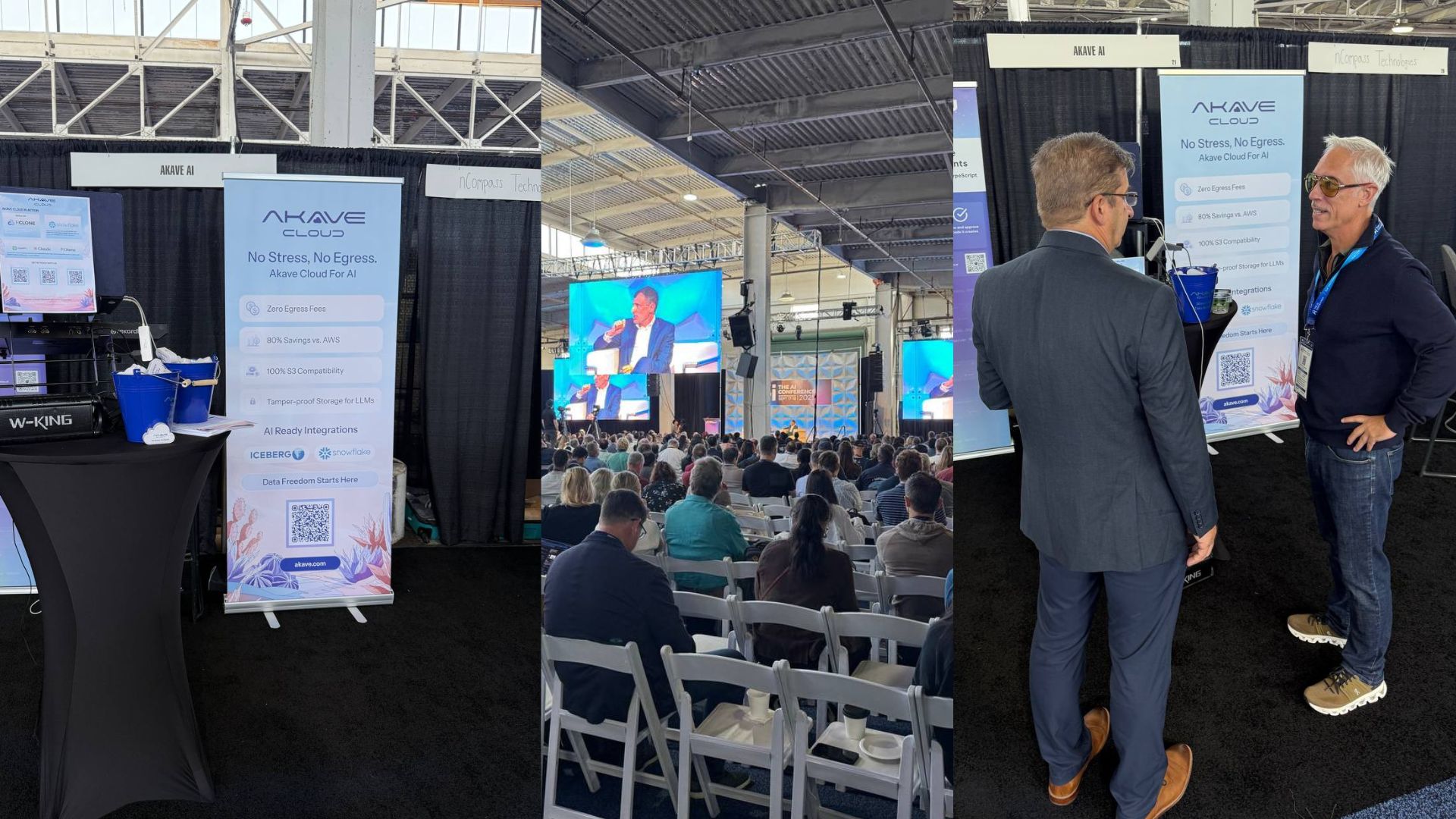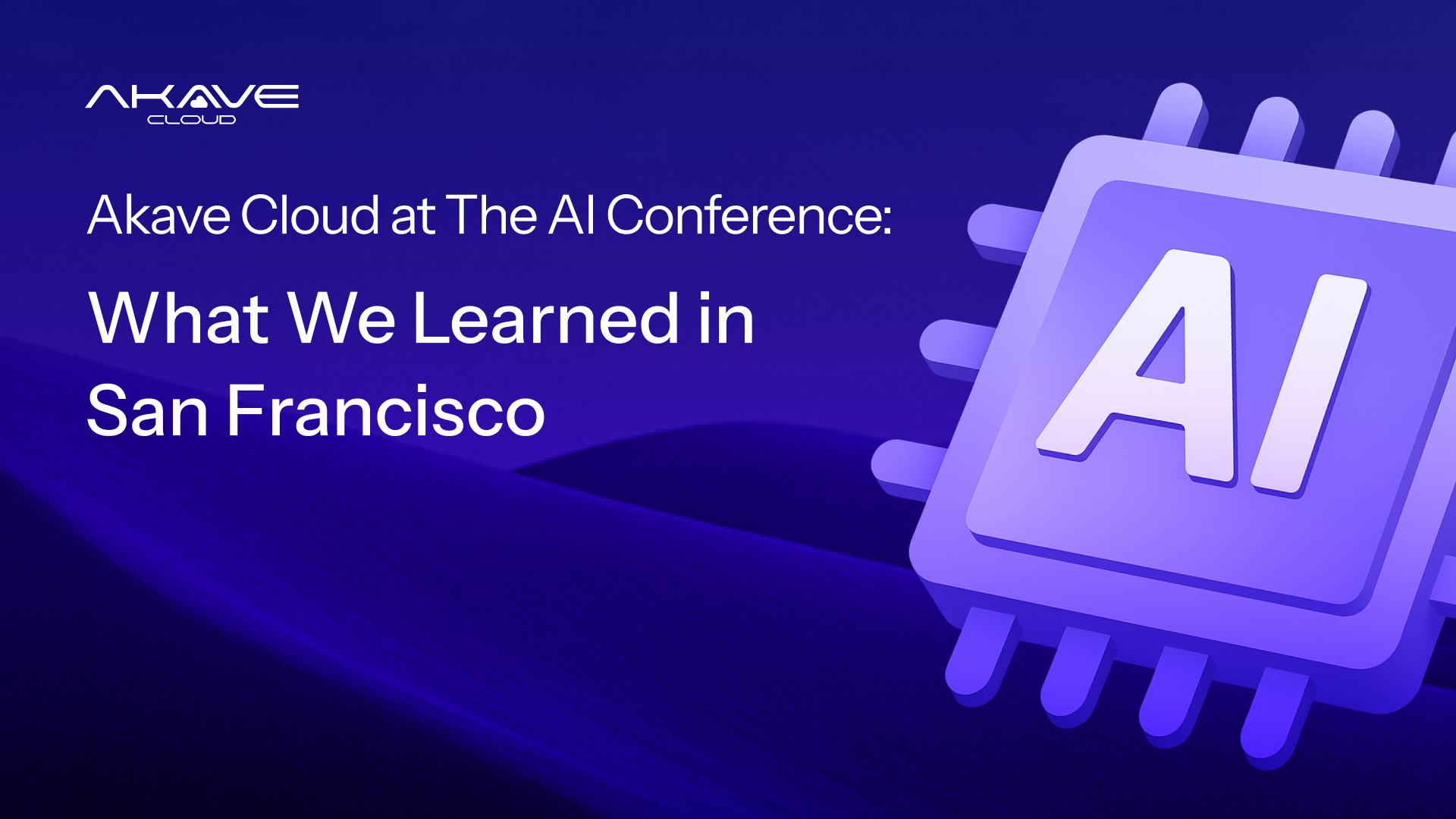The AI Conference in San Francisco brought together more than 2,500 people across the AI ecosystem, from LLM researchers and infrastructure leads to enterprise architects, media teams, and fast-moving startups. The energy was unmistakable. San Francisco has its momentum back, and AI is clearly the driving force.
We went down there with one clear purpose: to show how Akave Cloud is redefining what a modern storage layer should be in the AI era.
Everyone Has an Infra Bottleneck
Across conversations, one theme kept surfacing: AI innovation is outpacing storage infrastructure.
At the conference I met:
- Engineers trying to find better tooling to orchestrate and debug their LLMs
- AI leaders looking for platforms with less vendor lock-in at lower cost
- Business leaders searching for new ways to improve customer experience
- Entrepreneurs testing new business plans and scouting for partners
Teams told us they’re still:
- Limited by access to enough GPUs
- Limited by budget to scale faster
- Discovering new tools daily to improve their efficiency
- Paying unpredictable egress fees to move datasets between tools
- Losing visibility over LLM and weights data lineage during fine-tuning
- Facing growing pressure from regulators and internal compliance teams
It was clear that teams across all stages of adoption, from those just exploring AI, to those deep into fine-tuning, are hitting the same wall: legacy storage isn’t built for how AI actually works.
What We Brought to the Table
We introduced teams to Akave Cloud, our programmable, verifiable, zero-trust object store for data-intensive workloads. Whether we were speaking with Snowflake users, AI engineers, or DePIN builders, the response was consistent:
- Zero egress fees — move and query TBs of data without cost penalties
- Onchain audit trails — verifiable provenance and full data lineage
- S3-compatible APIs — drop-in for your existing workflows
- Agent- and orchestration-ready — built for pipelines, not just storage
- Immutable by design — protect weights, datasets, and logs from tampering
This resonated especially with teams facing growing compliance burdens, security threats like LLM data poisoning, and cost pressures from traditional clouds.
Who We Spoke To (and What We Learned)
We had incredible conversations with:
- AI engineers asking how to debug and orchestrate multi-agent systems
- Media and marketing teams struggling with massive egress bills just to collaborate across regions
- Government and regulated industries looking for better security and guarantees on data access, transparency, and auditability
- Enterprise leaders rethinking their infrastructure to stay ahead of AI-driven competitors
Key Takeaways:
- AI engineers are becoming AI managers. Software engineers are becoming managers of AI agents, not just code, and are asking for stronger agent orchestration, observability and debugging tools, not just GPUs.
- Vendor lock-in is becoming unacceptable. More teams want to keep optionality open across compute and orchestration platforms. Platforms that offer free data movement are key to provide the flexibility necessary in this growth cycle of tools.
- Security is top of mind. As adoption grows, so do attack vectors. Advanced teams are asking how to guarantee integrity of LLM weights over time. How do you prove an LLM was not tampered with through data poisoning? Immutable, verifiable logs are key and onchain attestations of LLM snapshots and weights can provide strong integrity validation.
- Data is the new budget line. Infra costs are ballooning with more data being generated than originally budgeted for. Unpredictable fees (especially egress) are getting flagged by finance teams and more consistent cost profiles.
The Evolving Enterprise Adoption Curve
We spoke to teams across the adoption spectrum:
The AI Explorer
The traditional business beverage, industrial, etc.) that is still in their early stage looking for a first safe step. They know their private datasets are valuable, they know they need to take action, but aren’t sure where to start. They don’t know what context to feed LLMs to get a good ROI. A pragmatic start that seems to resurface: use the classic ML stacks to extract stable signals, then use those as structured context to train your LLMs. Here Snowflake and Databricks kept popping up to extract those signals.
The Concept Testers
Are in the process of running POCs (Proof Of Concepts) with LLMs but haven’t settled down yet. They are shopping for GPUs + libraries to speed up fine-tuning and trying out different tools and platforms. Main concern: don’t get stuck on one platform. They want the flexibility to choose the right platform for their environment.
The Advanced fine-tuner
Already deep in fine-tuning and is thinking about how to scale and secure these LLMs. They understand the challenges, focus on safety and controls, and rely heavily on logging to track improvements and guarantee. Main concern: how to prevent LLMs from data poisoning and other attacks. How do they ensure data lineage so there is proof of integrity. What they want: first-class observability/evaluation that’s designed for LLM workflows, not generic infra, but optimized orchestration tools. They want portable storage at no extra cost and verifiable lineage to move datasets and artifacts in a secure way.
The Integrated, LLM-enabled apps
SaaS teams are already shipping LLM enabled features. Their challenge is operational: tracing prompts, responses, and user experience at inference scale. LLM observability is key here. Players like Datadog were demonstrating LLM observability tools to track user behavior with those LLM enabled features.
Why Akave Cloud Resonates
If there’s one thing everyone I spoke to cares about, it’s this:
- Cost — infra is ballooning and unpredictable fees are slowing teams down.
- Choice of tools — with the zoo of platforms growing, nobody wants vendor lock-in and keep their options open.
- Security — attack vectors are multiplying, and risks like data poisoning of LLM weights, corporate espionage, and model thefts are top of mind for both enterprises and government. Many are still trying to figure out how to address this.
Akave Cloud fits right into this next chapter of AI infrastructure:
- Built for verifiable storage at scale
- Designed for plug-and-play orchestration
- Priced with zero egress and transparent flat rates
- Powered by a decentralized backend and trusted by forward-thinking AI teams

Connect with Us
Akave Cloud is an enterprise-grade, distributed and scalable object store designed for large-scale datasets in AI, analytics, and enterprise pipelines. It offers S3 object compatibility, cryptographic verifiability, immutable audit trails, and SDKs for agentic agents; all with zero egress fees and no vendor lock-in, saving up to 80% on storage costs vs. hyperscalers.
Akave Cloud works with a wide ecosystem of partners operating hundreds of petabytes of capacity, enabling deployments across multiple countries and powering sovereign data infrastructure. The stack is also pre-qualified with key enterprise apps such as Snowflake and others.


